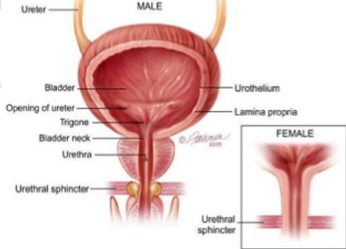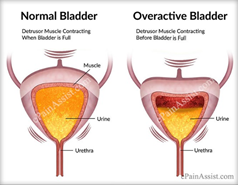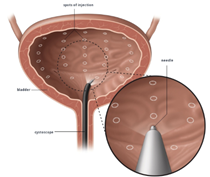BOTOX (BOTULINUM TOXIN TYPE A) FOR TREATMENT OF OVERACTIVE BLADDER (OAB)
A PATIENT INFORMATION SHEET
About Overactive Bladder (OAB)
The normal function of the bladder is to store urine as it is produced so that you can release urine at a time and place that is suitable and convenient for you.
As more urine is produced the bladder stretches like a balloon to hold it. Eventually it becomes so stretched and full of urine that the nerves in the bladder send a signal to the brain via the spinal cord, that it needs to empty. When your brain gets this message, it tells you to find a toilet. When you’re ready to empty the bladder the brain sends signals, via the spinal cord, to tell the sphincter muscles to relax and the bladder muscle to contract to push out all the urine. Then the whole process can start again.
During the course of a day, an average person will need to pass water / urine approximately 4-8 times. The rest of the time the bladder is in “storage mode”, quietly storing urine and allowing us to focus on our daily lives.
What is Overactive bladder (OAB)?
Overactive bladder, commonly referred to as OAB, is characterised by:
- Strong, sudden urge to urinate, known as “urgency”- this is the most common symptom of OAB. You may be worried that you won’t make it to the bathroom in time. You may or may not leak urine after feeling this urge.
- Frequent urination – you may need to go to the bathroom more than 8 times a day.
- Waking up at night to urinate – waking up more than once a night to urinate is another symptom of OAB.
What causes OAB?
OAB can happen when the nerve signals between your brain and your bladder tell you bladder to empty even when it isn’t full. OAB can also occur when the muscles in your bladder are overactive and contract before your bladder is full. The result is a sudden, strong urge to urinate that you cannot control.
OAB is a chronic and debilitating condition that can have a profound effect on quality of life, including physical, psychological, and limiting daily social and work activities.
Introducing BOTOX
What is Botox?
Botox is a natural, purified protein which has the ability to relax muscles. The active ingredient is botulinum toxin type A which is extracted from bacteria, under controlled laboratory conditions, in much the same way penicillin is produced from mould.
Botox is a prescription only medication.
BOTOX facts:
Botox works on the bladder nerves to relax the bladder. This helps to:
- Reduce bladder contractions
- Reduce the occurrence of urine leakage
- Reduce the feeling of needing to go to the toilet very suddenly
- Reduce how often you feel the need to pass urine.
- It may cause urine retention
- 60-70% will need repeat treatment
- If it fails, it recommended you wait 3-6months for alternative treatment
- It is temporary with a 6-12-month effect
- Retreatment may be needed.
Before Botox-
Before commencing BOTOX, your doctor will have carried out a number of tests to check that it is a suitable treatment for you and explained what it involves.
After Botox treatment, because the bladder has been “relaxed”, some people find that they cannot completely empty their bladder without using a technique knows as Intermittent Self Catheterisation (ISC). Not everybody who has Botox needs to use ISC, but it is a possibility you should be aware of and you will have an appointment with our nurse to explain and teach you how to do this.
You will also have a urine test (MSU) to check that you do not have a urinary tract infection (UTI) at the time of treatment.
What does the treatment involve?
When you have your treatment
- Your treatment with Botox will take place in hospital and is a day procedure either under a general or local anaesthetic to help minimise discomfort of the procedure
- To put the Botox into your bladder your doctor will use a cystoscope. This is a fine tube containing a tiny camera, that enables doctors to see inside the bladder
- Your doctor will inject tiny amounts of Botox into the muscle of your bladder. The whole procedure should be over in about 30 minutes
- Most people who have had Botox treatment in the bladder describe it as ‘uncomfortable ‘but not painful.
After your treatment it is important you follow your doctor’s care advice after you have received the Botox treatment.
You should see an improvement within 2 weeks after the injection and the effect typically lasts approximately 6 months. After this you and your doctor can decide whether you should have another treatment.
As with all medicines, Botox can cause side effects. The most common thing you might notice is blood in your urine and some bladder pain immediately after the procedure. This should pass fairly quickly and you can take some simple pain-relieving medicine.
NOTIFY GEELONG UROLOGY if you experience any of the following
- Heavy bleeding – urine that looks like pure blood
- Increased discomfort, sever pain and burning when passing urine
- Fever [temperature over 37.5 degrees]
- Unable to pass urine
- Cloudy or offensive urine.
- Inability or difficulty with emptying your bladder
FOLLOW UP APPOINTMENT
If an appointment time is not given to you on discharge from hospital, you will need to phone Geelong Urology to make an appointment.
Geelong Urology 03 5229 9105 during business hours
Or leave a message on the After-Hours Urology Paging Service 03 9387 1000



